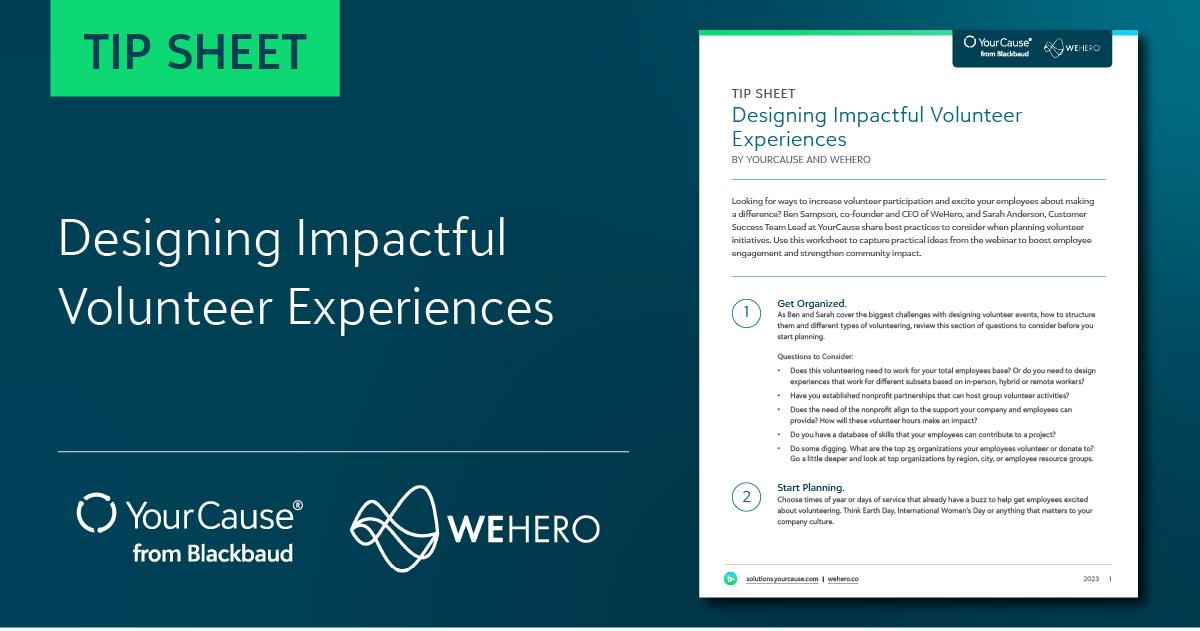Employee Volunteer Program Guide
Whether you’re completely new or an industry veteran, this guide will have info to help you make the largest impact possible. Use these links to jump to the section you’re interested in.
Benefits of Employee Volunteering
According to the Society for Human resources nearly half of US companies offer some form of employee volunteering. That number is higher for larger companies with 65% of CECP’s member companies offering a volunteer program that includes paid time off.1 Research has largely demonstrated that employee volunteering is beneficial for both employees and companies. We’ve summarized information from a few different articles showing the company level factors and individual factors that benefit from employee volunteering.
An employee volunteering program is a planned effort that seeks to motivate and enable employees to serve a community.2
Company Level Factors3
- Company Reputation
- Company Attractiveness
- Employee Retention
- Cross Departmental Team Building
It’s not hard to see the benefits of your company reputation within the community where your employees are giving back. This can boost the attractiveness to do business with your company or work for your company
Individual Factors
Job Performance and Leadership Development3 – Increased efficiency from skills development- employees gains increased efficiency from using their skills to solving problems and delivering results for a nonprofit organization. IT needs, marketing needs, or other skills-based projects for nonprofits would require employees to use their talents in ways that probably wouldn’t happen in their day-to-day at your company.
Need Satisfaction – Research has shown that volunteer participation increases need satisfaction from relatedness and competence.4 High need satisfaction related to higher job satisfaction and commitment.5
Well being6 – Phycologists call it the helper’s high. Volunteering in general has shown to improve mood, keeps people active and can help reduce stress levels, all having a significant impact on a person’s health.
Individual factors for job performance, leadership development and need satisfaction add up to company level factors! Well being has become increasingly important to CSR and HR professionals. With a decline in mental health and increased in feeling of loneliness employers look to support their employees mental and social health through benefits and policies.7
If you’re new to Corporate Social Responsibility and employee volunteer programs we recommend reviewing our getting started guide which starts with building the business case for making the investment and how to integrate CSR into your company’s mission. We’ve provided data on the power of purpose driven work as well as the latest statistics on the influence of CSR and ESG on a company’s bottom line.
“CSR serves the role of addressing employee concerns and preserving that collective sense of purpose. As company ambassadors, employees are critical in promoting organizational reputation. Their engagement is paramount, particularly with websites like Glassdoor™ offering megaphones to the dissatisfied.”
– Employees as Stakeholders from the Comprehensive Social Responsibility Report8
Creating an Employee Volunteer Program
Employee Volunteering is one part of a CSR program and like anything else requires thoughtful planning and consideration in order to reap the benefits. We’ve seen volunteer programs of all shapes and sizes over the years, with some companies creating highly structured outings that large teams participate in together or month long global campaigns to encourage employees to support any cause they are passionate about. There is a lot of opportunity to get creative with employee volunteer programs and build something tailored to engage your workforce.
But it can be difficult to get employees to take action. In a recent article on Harvard Business Review, Jessica Rodell reveals the three common mistakes that companies make when implementing a volunteer program:
- Copying Others
- Prioritizing Corporate Projects
- Making volunteering mandatory
Through her extensive research on corporate volunteer programs and consulting, she provides support for avoiding these pitfalls with best practices for connecting your program to your mission while creating flexibility to allow for more employees to get involved. This is a great article with tangible ideas for how to capitalize on employee’s interests and your company’s strengths, Volunteer Programs that Employees Can Get Excited About
Common Employee Volunteering Initiatives
Designated days of service can enable employees to dedicate time during their work week to get out in the community and serve. We have seen these implemented in different ways to accommodate what works best for each company culture. For example:
Office-wide: Each location or office chooses a day of service. The designated day is communicated to employees of that location. The day can accommodate employees’ schedules for that location.
Company-wide: A day of service that applies to everyone in the company regardless of location.
Rolling: A day of service that employees can choose based on their schedule. Employees work with their managers to signup for a day off to volunteer. This can be separate from employees earning paid time off for volunteering on their own time outside of work hours. This provides the most flexibility for the employee to dedicate time around what is going on in their lives at work or at home. Employees can sign up for a volunteer event to show proof of service on that day through CSR software.
Creating a disaster response plan is a vital elements of corporate social responsibility strategies. Organizing volunteers to cleanup after a natural disaster or serve in any way the community needs is an effective way to give back. Employees will want to know how they can help and support doesn’t go unnoticed in the community.
Volunteer campaigns can center around a certain time of the year or advocate for a special cause that aligns to a company’s mission and purpose. We typically see an extra emphasis on encouraging employees to serve when they can throughout the campaign or at organized volunteer team events setup in advance through nonprofit partnerships.
- Collaborate with employee ambassadors or employee resource groups to boost peer to peer engagement.
- Setup volunteer campaigns in CSRconnect to track event and hours. Create an engagement elements in CSRconnect as a landing page to show all campaign details.
- Don’t forget to celebrate and recognize employees at the end of your campaign by displaying total impact results and congratulating teams or individuals that made big contributions to the campaign’s success.
Customer Story
Learn more about Franklin Templeton’s Month of Service known as Impact Day’s and how they celebrate volunteerism.
Pro bono and skills-based volunteering leverages your employee’s talents to provide a need or solve a problem for nonprofits. It is important to partner with nonprofits to determine the needs and outline the deliverables. Along with the general benefits that come with employee volunteering programs, skills-based volunteering provides some additional benefits including but not limited to:
- translates very easily into a virtual environment
- provides exponential impact to nonprofits that lasts longer than the initial time spent delivering the service especially for capacity building projects
Assess Employee Skills
CSRconnect incorporates a way for employees to self identify what skills they align to, making it easy to build a list of employees that have the talents needed to organize a skills-based volunteer project. If you aren’t using a software for employee volunteering you could deploy a survey or email a list of the skills needed and ask employees to raise their hand if they align to the criteria.
Customer Story
Learn more about skills-based volunteering with HCA and get more tips on:
- Setting Expectations
- Preparing for Success
- Centralizing Resources
- Planning with the Future in Mind
Volunteer Incentives to Increase Engagement
The more your employees are participating in your programs, the greater the outcome for everyone. Employees will be happier, nonprofits will have more resources, and your company will be positively impacting your community. Get a quick definition of different types of volunteer incentives we’ve seen companies use over the years + examples.
Related Resources
Evaluating Your Programs
Companies are encouraging employees to engage in many different types of service to their community. Tracking progress can provide a way to communicate success, tell your story to prospective employees and provide insights into how to shape your program for the future.
Companies record employee volunteering hours as time given during a planned activity for a charitable group or nonprofit organization. Acts of service and kindness towards a friend or neighbor can also be encouraged and we’ve seen companies utilize the groups function in our employee engagement platform, CSRconnect, to setup forums where employees share their experiences, why they are passionate about supporting a cause or create a place to support each other.
Reporting Tools and Surveys
CSRconnect shows metrics on volunteer activity and utilization for groups like how many employees logged in to each one. You can also use CSRconnect to deploy surveys and collect feedback from your employees.
Share your Impact Story
Go beyond reporting outputs like the volunteer hours and giving amount and start sharing your impact story. We’ve rounded up a few resources to help you get started.
References
- CECP
- Effective Employee Volunteer Programs
- Employee Volunteering: A Review and Framework for Research
- The Role of Organization Inclusion and Volunteer Need Satisfaction
- Employee Need Satisfaction and Positive Workplace Outcomes
- Why Volunteering is Good for Employee Wellness
- Employee Benefit Trends
- Comprehensive Social Responsibility












